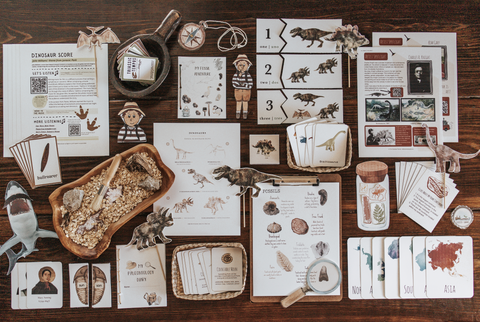
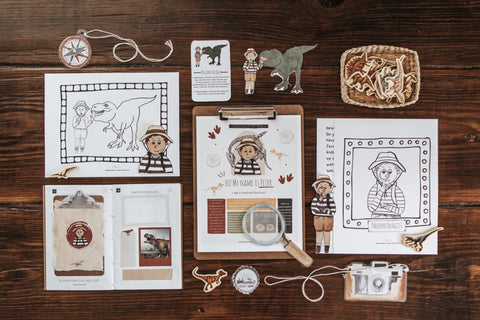
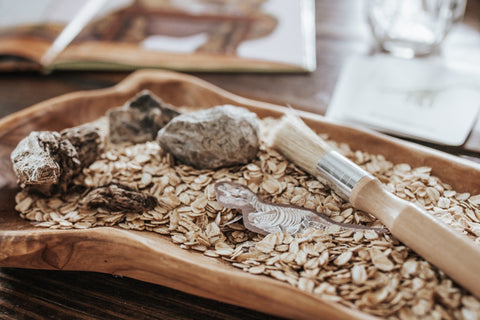

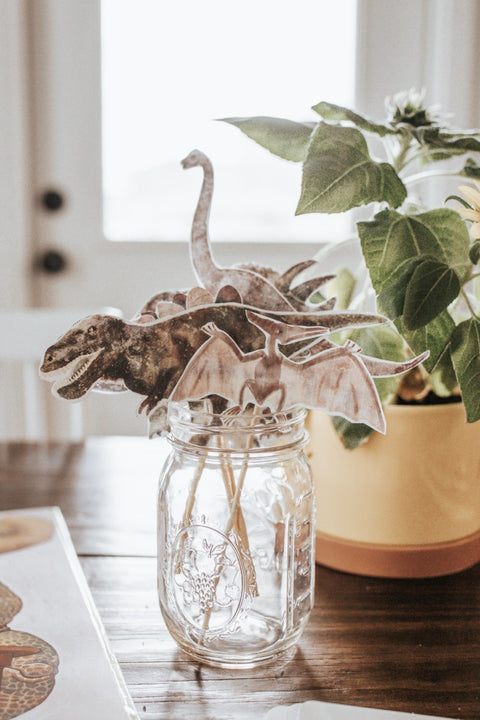
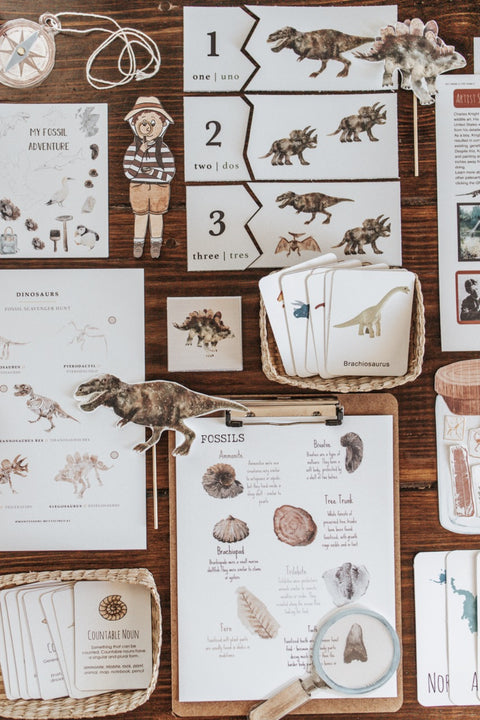
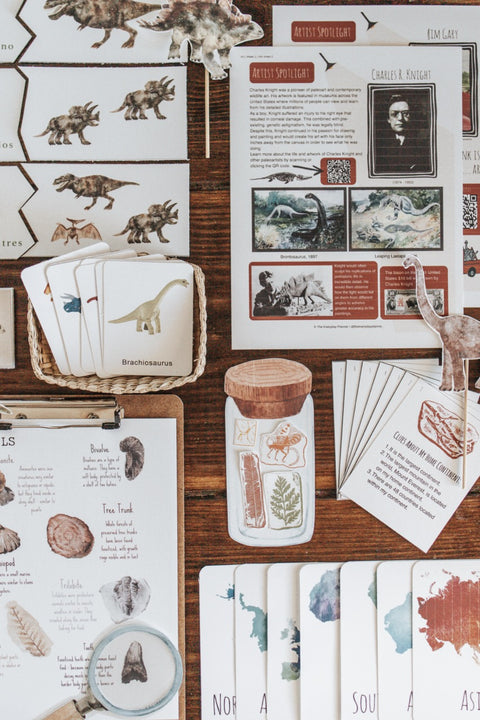
Harbor and Sprout
Paleontology Patchwork Study
Welcome to the Harbor + Sprout Paleontology Patchwork Study, originally released October 2021 and updated January 2025. This unit study features 4 weeks of lesson plans and materials covering all 9 of our core subjects plus a playful supplemental section of thematic activities. This unit study is meant for use by children ages 3-12.
This unit is delivered via a secure link as a digital download.
CONTENT:
Handbook
Daily, weekly, and monthly planning pages
Book list including stories, poems, and field guides with recommended ages, subject correspondence, and brief summaries for each title
Lesson plans for 4 levels of learning
Family read aloud with discussion guide and recipe
Character kit- new monthly character illustrated by Stephanie Groves
Science
Lesson 1: What is Paleontology?- In this lesson, you will uncover the fields of application of paleontology, and learn what fossils teach us. You will reconstruct ancient environments, label the essential tools, and compare fossils to modern animals.
Lesson 2: How to Classify Fossils?- In this lesson, you will explore different types of fossils and how they form. You will make your own fossil, solve a fossil mystery box, and reconstitute a fossilized food chain to understand how ecosystems functioned.
Lesson 3: What are Dinosaurs?- In this lesson, you will explore different types of dinosaurs.You will classify dinosaurs into groups, reconstruct a dinosaur skeleton, and experiment with eggshell strength to understand how dinosaur eggs were protected.
Lesson 4: How to Date Fossils?- In this lesson, you will explore the geological time scale, learn how fossils form, and discover the methods used to date them. You will bake a stratigraphy cake, and simulate carbon and luminescence dating.
Nature Study
Lesson 1: The Mammoths-
In this lesson, you will explore a type of elephant that went extinct thousands of years ago, the woolly mammoth. You will learn of their origins, migrations over millions of years, and relationships between other types of elephants.
Lesson 2: The Mammoth Steppe-
In this lesson, you will dive deeper into the woolly mammoth and the area of the prehistoric world in which early mammoths lived, called the mammoth steppe. You will explore its landscape, including weather and foliage.
Lesson 3: Ice Age Adaptations-
In this lesson, you will explore the Last Glacial Period, otherwise known as the Ice Age. You will learn about the special adaptations that woolly mammoths had to help them survive in that harsh environment.
Lesson 4: Mammoths & People-
In this lesson, you will discover what we know about Ice Age people who lived alongside woolly mammoths. You will learn about the roles of these people, how they used mammoths, and the ways they celebrated this creature.
Language Arts
Week 1: "The Nautilus & the Ammonite"-
In this lesson, you will understand and enjoy the poem written by G.F. Richardson, a geologist and curator of the British Museum, “The Nautilus and the Ammonite.” You will explore this poem through analysis and creativity.
Week 2: Nouns-
In this lesson, you will understand the function of a noun and be able to identify the different types of nouns, including common, proper, singular, plural, concrete, abstract, countable, uncountable, and collective.
Week 3: Homophones-
In this lesson, you will understand what a homophone is and be able to recognize and distinguish between common homophones. You will read through some common examples and come up with your own.
Week 4: Etymology-
In this lesson, you will understand that words have an origin and that they change through time. You will explore languages, how to break words down into smaller sections, and recurring words related to Paleontology.
Writing
Week 1: Plan-
Over the next four lessons, you will write a report about one of three topics. In this lesson, you will choose your topic, determine what you already know, write out three questions you want to answer in your report, and find reliable sources.
Week 2: Research, Statement, and Outline-
In this lesson, you will begin your researching your selected topic. You will gather your materials, take notes, answer the questions you posed, write your thesis statement, develop your argument, and create an initial outline.
Week 3: First Draft-
In this lesson, you will write your first draft. You will gather your materials, reread your topic and outline, write your thoughts (does not need to be perfect), and finally fill in details throughout your report as needed.
Week 4: Revise-
In this lesson, you will finalize your project. You will reread your first draft to edit the content, then you will reread it again to proofread for mistakes, such as grammar, spelling, etc, and then you will write a final draft.
History
Week 1: Let's Dig In-
In this lesson, you will discover the meaning of paleontology and fossils. You will learn that paleontology is the study of life on earth through fossils which are not just dinosaur bones but include plants, mammals, reptiles, etc.
Week 2: Mary Anning-
In this lesson, you will discover the impressive life and work of Mary Anning. You will learn about her upbringing and family, her educational experience, and her long line of historically significant discoveries.
Week 3: Fossil Hunters-
In this lesson, you will discover the life and contributions of Kamoya Kimeu and how the Leaky Family recruited him on their expeditions becuase of his unique set of skills. You will explore Eastern African countries.
Week 4: Jurassic Jack-
In this lesson, you will discover fossil hunter, Jack Horner. You will learn about his weaknesses and strengths in school and how his passions led to making discoveries that would make a significant impact on paleontology.
Geography
Week 1: Continents of the World-
In this lesson, you will explore each of the seven continents of the world through the lens of fossils. You will learn notable landmarks, characteristics and statistics, and general facts about each continent while searching for fossils.
Week 2: Petrified Wood-
In this lesson, you will discover that wood from trees can become fossilized over long periods of time, and this wood is called petrified wood. You will explore areas this wood can be found and what it looks like.
Week 3: Antarctica-
In this lesson, you will explore the southernmost continent, Antarctica. You will learn why scientists make the long and difficult journey to Antarctica to learn and study its land, surrounding water, biome, and inhabitants.
Week 4: Baltic Coast Amber-
In this lesson, you will discover how amber (fossilized resin) is created over time and what it looks like. You will learn that the Baltic Sea contains one of the highest concentrations of amber in the world and other facts.
Music
Week 1: Prehistoric Echoes-
In this lesson, you will explore prehistoric sounds. You will learn about the technologies used to study prehistoric acoustics, uncovering how scientists recreate dinosaur calls and the soundscapes of ancient environments.
Week 2: Camille Saint-Saens' Fossils-
In this lesson, you will delve into the whimsical charm of Fossils by Camille Saint-Saëns, a movement from his beloved Carnival of the Animals. You will uncover how he used melodies and instrumentation to evoke ancient creatures.
Week 3: Aurignacian Flutes-
In this lesson, you will study the Aurignacian flutes. You will learn about the ancient craftsmanship behind these musical instruments, and uncover how our ancestors used music to connect with their environment and community.
Week 4: Jurassic Park Theme-
In this lesson, you will delve into the awe-inspiring world of cinematic music by exploring the iconic Jurassic Park. You will learn how composers used melodies and orchestral grandeur to evoke the majesty of dinosaurs.
Art
Week 1: Paleoart-
In this lesson, you will explore paleoart which is when an artist uses scientific evidence to depict prehistoric life through art. You will look at examples of such art and then learn about the life and work of Charles R. Knight.
Week 2: Art Elements-
In this lesson, you will explore two basic types of texture in art: real and implied. You will observe textures used to depict the surface of dinosaurs based on scientific research, discoveries, and evidence of paleontologists.
Week 3: Realism & Surrealism-
In this lesson, you will explore the differences and similarities in realism and surrealism in art, study pieces and artists of each style, and use your imagination to create your own dinosaur inspired surrealistic piece of art.
Week 4: Upcycling-
In this lesson, you will discover the fascinating world of upcycling which is when you take discarded items and repurpose them into something useful or artistic. You will learn about one sculptor who upcycled his whole life.
Math
Week 1: Dinosaur Dominoes-
In this activity, you will practice your number matching and adding skills while playing a dinosaur-themed round of dominoes. You will use a number key to determine the value of each dinosaur picture or create your own.
Week 2: Jurassic Math-
In this activity, you will create equations, math problems, equalities, and other math expressions, sort fossils by color, size, shape, and type, make patterns, and compare and contrast using a Venn diagram.
Week 3: Place Value Sliders-
In this activity, you will practice your number skills by placing them in different place values. You will spin and slide numbers to make very small numbers less than 0 and/or very big numbers in the tens of millions.
Week 4: Skip Counting Dot-to-Dot Puzzles-
In this activity, you will practice your skip counting skills with various numbers which will strengthen your current or future multiplication skills. You can use three different dot-to-dot puzzles at varying levels of difficulty.
Supplement
Thematic & Bilingual Activities
Dinosaur Stick Puppets
Dinosaur Counting in Spanish
Dinosaur Fossil Matching
Dinosaur Sensory Bin
Writing & Language Arts
Vocabulary
Spelling Practice
Fossil Spelling Puzzles
Spelling Cards
Paleontology Story
Copywork
Writing Process Reference Pages
Revision Practice
Coloring Pages
This unit will be delivered digitally as a downloadable zip file. H+S Patchwork Studies average approximately 550-650 pages of content. While the download does include the option to print the full unit straight through front and back, we recommend printing on an as-needed, as-you-go basis. Enjoy your paleontology adventures!
